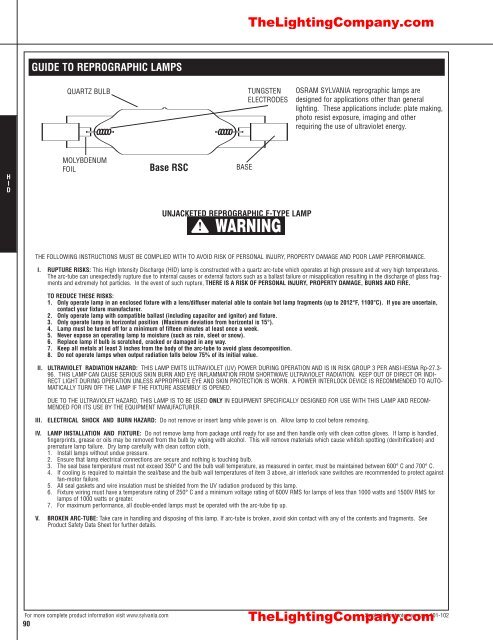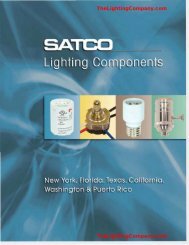Lamp and Ballast Catalog - The Lighting Company
Lamp and Ballast Catalog - The Lighting Company
Lamp and Ballast Catalog - The Lighting Company
- No tags were found...
You also want an ePaper? Increase the reach of your titles
YUMPU automatically turns print PDFs into web optimized ePapers that Google loves.
<strong>The</strong><strong>Lighting</strong><strong>Company</strong>.com<br />
GUIDE TO REPROGRAPHIC LAMPS<br />
QUARTZ BULB<br />
TUNGSTEN<br />
ELECTRODES<br />
OSRAM SYLVANIA reprographic lamps are<br />
designed for applications other than general<br />
lighting. <strong>The</strong>se applications include: plate making,<br />
photo resist exposure, imaging <strong>and</strong> other<br />
requiring the use of ultraviolet energy.<br />
MOLYBDENUM<br />
FOIL<br />
BASE<br />
H<br />
I<br />
D<br />
UNJACKETED REPROGRAPHIC F-TYPE LAMP<br />
THE FOLLOWING INSTRUCTIONS MUST BE COMPLIED WITH TO AVOID RISK OF PERSONAL INJURY, PROPERTY DAMAGE AND POOR LAMP PERFORMANCE.<br />
I. RUPTURE RISKS: This High Intensity Discharge (HID) lamp is constructed with a quartz arc-tube which operates at high pressure <strong>and</strong> at very high temperatures.<br />
<strong>The</strong> arc-tube can unexpectedly rupture due to internal causes or external factors such as a ballast failure or misapplication resulting in the discharge of glass fragments<br />
<strong>and</strong> extremely hot particles. In the event of such rupture, THERE IS A RISK OF PERSONAL INJURY, PROPERTY DAMAGE, BURNS AND FIRE.<br />
II.<br />
TO REDUCE THESE RISKS:<br />
1. Only operate lamp in an enclosed fixture with a lens/diffuser material able to contain hot lamp fragments (up to 2012°F, 1100°C). If you are uncertain,<br />
contact your fixture manufacturer.<br />
2. Only operate lamp with compatible ballast (including capacitor <strong>and</strong> ignitor) <strong>and</strong> fixture.<br />
3. Only operate lamp in horizontal position (Maximum deviation from horizontal is 15°).<br />
4. <strong>Lamp</strong> must be turned off for a minimum of fifteen minutes at least once a week.<br />
5. Never expose an operating lamp to moisture (such as rain, sleet or snow).<br />
6. Replace lamp if bulb is scratched, cracked or damaged in any way.<br />
7. Keep all metals at least 3 inches from the body of the arc-tube to avoid glass decomposition.<br />
8. Do not operate lamps when output radiation falls below 75% of its initial value.<br />
ULTRAVIOLET RADIATION HAZARD: THIS LAMP EMITS ULTRAVIOLET (UV) POWER DURING OPERATION AND IS IN RISK GROUP 3 PER ANSI-IESNA Rp-27.3-<br />
96. THIS LAMP CAN CAUSE SERIOUS SKIN BURN AND EYE INFLAMMATION FROM SHORTWAVE ULTRAVIOLET RADIATION. KEEP OUT OF DIRECT OR INDI-<br />
RECT LIGHT DURING OPERATION UNLESS APPROPRIATE EYE AND SKIN PROTECTION IS WORN. A POWER INTERLOCK DEVICE IS RECOMMENDED TO AUTO-<br />
MATICALLY TURN OFF THE LAMP IF THE FIXTURE ASSEMBLY IS OPENED.<br />
DUE TO THE ULTRAVIOLET HAZARD, THIS LAMP IS TO BE USED ONLY IN EQUIPMENT SPECIFICALLY DESIGNED FOR USE WITH THIS LAMP AND RECOM-<br />
MENDED FOR ITS USE BY THE EQUIPMENT MANUFACTURER.<br />
III.<br />
IV.<br />
ELECTRICAL SHOCK AND BURN HAZARD: Do not remove or insert lamp while power is on. Allow lamp to cool before removing.<br />
LAMP INSTALLATION AND FIXTURE: Do not remove lamp from package until ready for use <strong>and</strong> then h<strong>and</strong>le only with clean cotton gloves. If lamp is h<strong>and</strong>led,<br />
fingerprints, grease or oils may be removed from the bulb by wiping with alcohol. This will remove materials which cause whitish spotting (devitrification) <strong>and</strong><br />
premature lamp failure. Dry lamp carefully with clean cotton cloth.<br />
1. Install lamps without undue pressure.<br />
2. Ensure that lamp electrical connections are secure <strong>and</strong> nothing is touching bulb.<br />
3. <strong>The</strong> seal base temperature must not exceed 350° C <strong>and</strong> the bulb wall temperature, as measured in center, must be maintained between 600° C <strong>and</strong> 700° C.<br />
4. If cooling is required to maintain the seal/base <strong>and</strong> the bulb wall temperatures of item 3 above, air interlock vane switches are recommended to protect against<br />
fan-motor failure.<br />
5. All seal gaskets <strong>and</strong> wire insulation must be shielded from the UV radiation produced by this lamp.<br />
6. Fixture wiring must have a temperature rating of 250° C <strong>and</strong> a minimum voltage rating of 600V RMS for lamps of less than 1000 watts <strong>and</strong> 1500V RMS for<br />
lamps of 1000 watts or greater.<br />
7. For maximum performance, all double-ended lamps must be operated with the arc-tube tip up.<br />
V. BROKEN ARC-TUBE: Take care in h<strong>and</strong>ling <strong>and</strong> disposing of this lamp. If arc-tube is broken, avoid skin contact with any of the contents <strong>and</strong> fragments. See<br />
Product Safety Data Sheet for further details.<br />
<strong>The</strong><strong>Lighting</strong><strong>Company</strong>.com<br />
For more complete product information visit www.sylvania.com Symbols/Footnotes on page 101-102<br />
90




